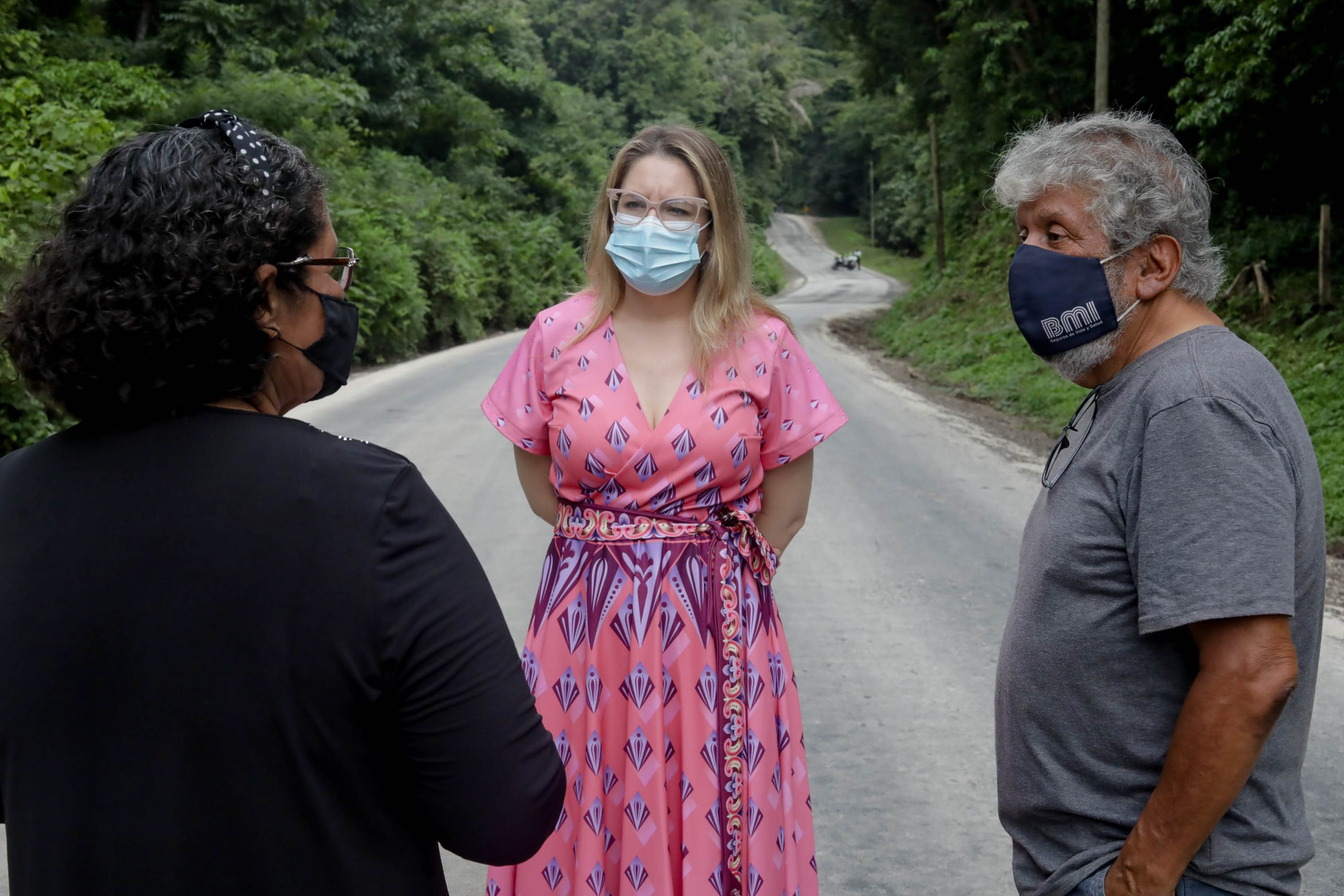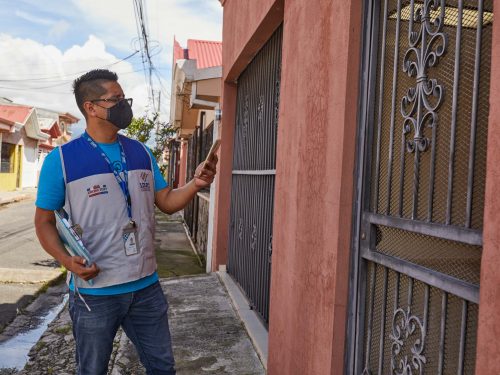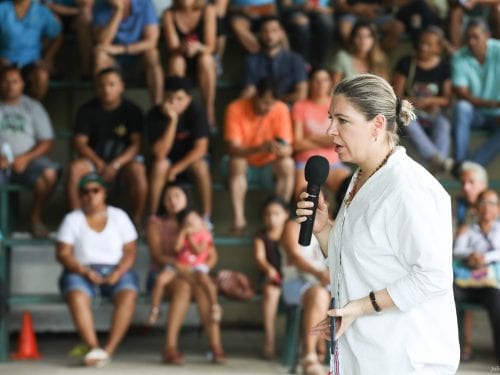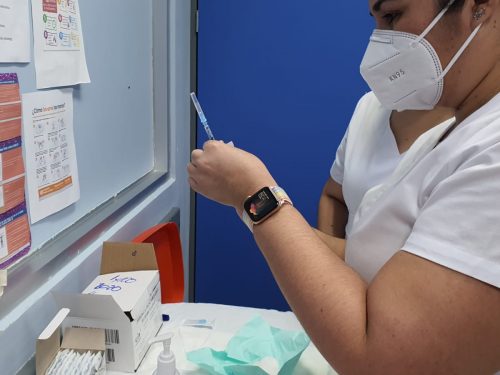
What will happen to the road infrastructure projects that the construction companies MECO and H Solis are in charge of in the Chorotega region due to the Cochinilla case? Is it possible that the government should put them on hold? Is a recovery in sight for the province’s economy and employment? What is the current administration doing to support growth for the lowlands?
First Lady Claudia Dobles, the coordinator of the Chorotega region, toured different projects underway in the 11 cantons of Guanacaste. On Wednesday, July 21, Dobles agreed to an exclusive interview with The Voice of Guanacaste.
In relation to the anniversary of the annexation of the Party of Nicoya, Dobles spoke with The Voice about the challenges facing the province and the Chorotega region, the measures they are adopting to address them and how quickly the area can recover after the pandemic’s blows .
To her, the big challenges include closing gaps in second language proficiency and in Internet access, two areas in which progress is required to strengthen employment opportunities and improve education quality.
Unemployment, on the other hand, clouds the Chorotega region’s progress with a rate of 18.4%, according to the latest report from the National Institute of Statistics and Censuses (INEC- Instituto Nacional de Estadística y Censos). Before the pandemic, it didn’t surpass 14%.
On this issue, the first lady affirmed that strategies to position Guanacaste as a more desirable tourist destination, such as the adjustment of business rates in the airlines and the recent rebranding of Daniel Oduber airport, are increasing the number of tourists and will continue to do so, which will allow the economy, as well as employment, to grow in the short term.
Dobles also spoke with The Voice about repercussions that could be caused by the notorious Cochinilla case, the corruption investigation that involves, among others, the National Highway Council (CONAVI- Consejo Nacional de Vialidad) and the companies H Solis and MECO, two private construction companies that have contracts to work on some routes in the Chorotega region. The first lady pointed out that the government has been transparent in admitting that some work may be put on hold until CONAVI — which has intervened — can ensure that the projects were managed properly in the past.
This is the interview edited slightly for space and organized by subject matter:
One effect of the pandemic undoubtedly is an increase in unemployment. Are there proposals or projects to address this problem in the short term in Guanacaste?
Well, the first thing is that the province has a strong link with the tourism industry so I think that unemployment is still the reaction that continues from the practically zero visitation year that we had last year.
Undoubtedly, the improvement in the tourism industry will have an impact in the short term on this unemployment rate, because this unemployment rate not only occurs in the people who made a living directly from tourism but also in the indirect connections that tourism generates.
That’s why we’ve also given a high priority to being able to recover that industry, because things will very quickly pick up for the people who had employees; they’ll need them again and it will pull up other productive industries, many of them, business and agriculture. That’s going to have an impact on the region in the very short term.
In the medium and long term, betting on diversification, strengthening the agricultural industry, the diversification of production in the agricultural industry, plus being able to incorporate other productive industries into the region is what is going to make the region more resilient, without a doubt. And there, possibly the clearest bet is bilingualism.
But that will be in the medium and long term. Possibly in the short term, what will have a more significant impact, at the level of the Chorotega region, will be the recovery of tourism. Fortunately, we’re seeing a very positive projection.
Promoting visitation to the airport in Liberia is related to the tourism industry. What measures have been taken in this regard?
One measure that came from the dialogue table was the subject of looking for mechanisms that would generate greater competitiveness in airport rates, in the airport’s own rate, at a more operational level. But with the [30%] lower fare, that means that the airline has a lower cost for coming here and, as a result, that can have an impact on lowering its rates [to passengers]. And, sure enough, it did have results. We had airlines that lowered their rates, their final rates now to the public.
Other initiatives that we are going to have tomorrow here at the airport are added to this.
(The day after the interview, the airport management company announced the branding change).
Earlier, you mentioned the diversification of agriculture. How are you looking to achieve that?
In the agricultural industry, there are big opportunities. Shall we say, at some point — because of the context, because of the information that we had, the technology that we had — it was thought that in Guanacaste, you couldn’t grow vegetable products but instead, they are brought from other regions. There’s an effort now to diversify the agricultural industry with other products. Not just these, but other products with other markets, with products that are linked to well-being and health. And obviously this, making the agricultural industry more technological, incorporating sustainability measures that make it more competitive, that position it better in the market. And closing that gap that is sometimes thought and that isn’t true, that’s a false dichotomy between the agricultural part and the sustainability part; instead we can unite them.
In fact, today we were at a project to deliver 12 water reservoirs, a process of capturing, let’s say, water harvesting, which is completely sustainable, which makes the most of the water resource and which strengthens the agricultural industry.
So, there are several efforts, not only to incorporate new products for the industry, but also to make the sector more technological and incorporate sustainability measures that also give added value to the final product.

This is the first of a total of 12 water reservoirs that are intended to guarantee the necessary water for livestock activities in the province. Photo: Presidential House︱Roberto Carlos Sanchez
How can the economy be diversified when the educational courses available are highly focused on tourism and administration?
Well, but a key to diversifying the economy is having a bilingual population. In other words, the bilingual population isn’t just used for tourism. Guanacaste has tourism. Guanacaste has the potential to become a hub of services. There are companies interested, but we need more people who speak English. And there you diversify it at the level of services, and an interesting level of services, with salaries that can be interesting.
That’s why the subject of bilingualism is so important and is going to have such a significant impact on the diversification of the economy, which goes far beyond the tourism industry.
It was announced that more than 3,000 people will be trained in English in the region between this year and next. Who’s in charge of giving this training?
Two public institutions lead the ecosystem. One is INA (the National Learning Institute- Instituto Nacional de Aprendizaje). Another is the Ministry of Labor. They are slightly different programs and are also done in a public-private partnership. For example, the Guanacaste Job Fair was launched, a joint effort by the entire institutional ecosystem and Sykes.
As a matter of fact, in an interview with The Voice, the director of Corporate Affairs at Sykes told us about the difficulties of finding people with an acceptable level of English for employability or even with an interest in studying the language. How can this be dealt with?
Yes, we have a big challenge there. One of the subjects that comes up from that exercise and that we also said in honor of transparency, we’ve said it twice, is that for the Cinde Job Fair, for example, we had — and that is an investment that is made — a number of tests to map the region. This would also allow us to understand where our target population is and how we can incorporate it into the programs.
Many people signed up, filled out the form, but didn’t take the test.
So, we also encourage people to take advantage of these real opportunities, because that is an investment that is made from the public side, but we also need continuity, a commitment from the people to complete the process to be able to connect it.
As a result of the Cochinilla case investigation, what is the government’s commitment to provide continuity in the region to the road infrastructure work that the investigated construction companies were in charge of?
Here I believe that the government has been blunt on two issues. The first is that we have to guarantee Costa Ricans correct, transparent processes and that the consequences are established accordingly, if there has been an incorrect act by public officials. So, from this point on, the government of the republic has repudiated any act of corruption and the president of the republic himself made a request for CONAVI to intervene, and as a result of that request, important interventions have been made in CONAVI.
On the other hand, we’ve also said no, Costa Rica can’t come to a halt. So, it’s a matter of finding a balance to see how we can be transparent, review, in some cases putting a hold on some processes unfortunately. But yes, we do intend to provide continuity and push everything that is infrastructure investment, because that is development. That is social progress. It’s job creation. So we can’t bring the country to a halt. Besides, infrastructure investment isn’t just in road infrastructure. And yes, the policy is we have to provide continuity, correct what has to be corrected, establish the responsibilities that need to be established, collaborate fully with the processes that the Prosecutor’s Office is currently carrying out. But the country has to move forward.

The first lady visit the asphalt seal on Route 234, between Samara and Nicoya. Photo: Presidential House︱Roberto Carlos Sanchez
In 2019, you announced the asphalt layer for Route 160 and three bridges. Part of that debt was already settled with asphalt on the first 10 kilometers (6 miles), but the bridges are still lacking since the budget ran out. What are the plans for this route?
Well, the three bridges along Route 160 were submitted in the last budget that went to the Legislative Assembly, which the decision will be made on after getting the budget related to CONAVI to submit it independently, since the legislators wanted to be able to review it independently.
That extraordinary budget will be submitted again to the Legislative Assembly. Those three bridges would go within that extraordinary budget, like the commitment we have kept with the community.
The construction company in charge of this project was MECO. Would they remain in charge of the project if the budget advances?
CONAVI is in this process. Just yesterday, in the area of progress, we said transparently that at this moment some of CONAVI’s works are on hold because the processes are being reviewed to guarantee that they were adequately awarded. So, first is the budget and from there, the process would come. I believe that the first commitment is that we have the budget to be able to build those bridges and that commitment would be in the next extraordinary budget that would be submitted to the Legislative Assembly.
To be wrapping up, and going back to the beating from the pandemic, we can’t put education aside. Has the educational gap in the region widened after the pandemic, taking into account the lack of Internet access in some areas?
I think it’s clear that yes, we do have a gap in some services and in some infrastructure between the greater metropolitan area and many of our more rural areas, and there is a commitment to accelerate it. The pandemic made evident precisely those gaps that already existed. But under the understanding that we have these gaps, it’s been since the beginning of 2019 that the president of the republic has created presidential delegates for the different territories so that specific strategies are made to map what those gaps that each of the regions has are and so the potential and deficits that each region may have can be worked on in a much more detailed way.
I think the [Internet] connectivity issue is an issue that’s not specific to the Chorotega region and that is being addressed at the national level. For this, for example, there is also the Digital Literacy bill, which we are optimistic will pass in the Legislative Assembly to be able to progress faster and more decisively with the issue of closing that digital gap, which is one of the ones that I think is evident between the greater metropolitan area and the other regions.
What has been the biggest challenge in this work table for the Chorotega region?
Possibly the balance between the time the processes take, what we can accelerate in the processes while making them transparent and improving them, versus the urgency of the people. The answers people need are very short-term.
And in terms of work areas, which has shown a greater lag than expected?
If anything, I’d tell you that I think we’ve made very important progress in the region at the level of infrastructure. I believe that; we’ve had a very significant advance at the level of the gravel roads strategy. We’ve had an important advance at the infrastructure level in general.
I also believe that we still have big challenges in closing gaps. Although we’ve made progress, we have big challenges in closing gaps at the level of bilingualism and at the level of [Internet] connectivity.







Comments